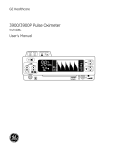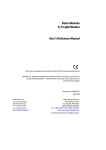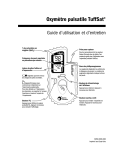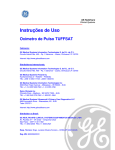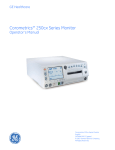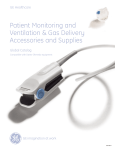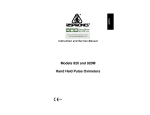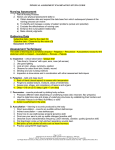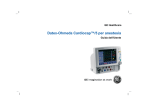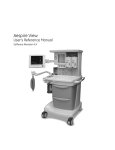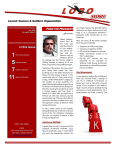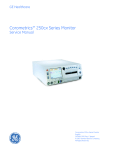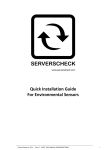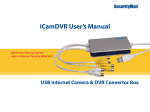Download TruSat™ Pulse Oximeter
Transcript
GE Healthcare TruSat™ Pulse Oximeter User’s Guide GE Healthcare TruSat™ Pulse Oximeter User’s Guide 6050-0006-815 March 2005 Important Rx Only (USA) Attention! Consult the accompanying instructions, including all safety precautions, before using this device. Responsibility of the manufacturer The safety, reliability, and performance of this device can be assured by the manufacturer only under the following conditions: • Assembly, extensions, readjustments, modifications, and repairs are carried out by authorized personnel. • The electrical installation complies with relevant standards and regulations. • The device is used in accordance with this manual and is serviced and maintained in accordance with the TruSat Technical Reference Manual. Service and repair Service and repair procedures must be performed by authorized service personnel. Repair this device or its parts only in accordance with instructions provided by the manufacturer. To order replacement parts or for assistance, contact an authorized service office. When shipping the monitor for repair, clean the monitor, allow it to dry completely, and pack it for shipment in the original shipping container, if possible. Trademarks Datex®, Ohmeda®, TruSat™ and other trademarks (ComWheel™, OxyTip®, PIr®, TruSignal™, TruTrak®) are the property of GE Healthcare Finland Oy. All other product and company names are the property of their respective owners. 0537 GE Healthcare Finland Oy Helsinki, Finland +358 10 394 11 www.gehealthcare.com © 2005 General Electric Company. All rights reserved. Contents 1. Overview Monitor description...................................................................................................1–1 Trend Download option.......................................................................................................................1–1 Intended use .............................................................................................................................................1–1 TruSat pulse oximetry .............................................................................................1–2 TruSignal Enhanced SpO2 ..................................................................................................................1–2 PIr pulsatile value ...................................................................................................................................1–2 Measurement characteristics ..........................................................................................................1–2 Interfering substances................................................................................................................1–3 Calibration ........................................................................................................................................1–3 Safety precautions ....................................................................................................1–4 Warnings.....................................................................................................................................................1–4 Cautions ......................................................................................................................................................1–4 Electromagnetic compatibility (EMC)............................................................................................1–4 Disposal.......................................................................................................................................................1–4 2. Features and Use Monitor features.........................................................................................................2–1 Connectors.................................................................................................................................................2–2 Information label and symbols .......................................................................................................2–2 Buttons and indicators ........................................................................................................................2–3 Power button and power LED.................................................................................................2–3 Alarm Silence button and indicator .....................................................................................2–3 Alarm LED..........................................................................................................................................2–3 Battery indicator............................................................................................................................2–4 On-screen controls ................................................................................................................................2–4 Using the monitor ......................................................................................................2–5 Monitor checkout....................................................................................................................................2–5 Choosing the sensor .............................................................................................................................2–6 Connecting the sensor.........................................................................................................................2–6 Monitoring the patient .........................................................................................................................2–7 Plethysmographic pulse bar (pleth bar).............................................................................2–7 Changing monitor settings ...................................................................................2–8 Using the ComWheel ............................................................................................................................2–8 Setting alarm limits................................................................................................................................2–8 Adjusting pulse beep and alarm volume....................................................................................2–9 Switching the backlight ON/OFF.....................................................................................................2–9 Locking/unlocking monitor settings..............................................................................................2–9 Displaying the perfusion index (PIr)............................................................................................ 2–10 Changing the line power filter....................................................................................................... 2–10 i Contents 3. Alarms, Troubleshooting, & Maintenance Alarms ..............................................................................................................................3–1 Alarm priorities.........................................................................................................................................3–1 Alarm activation ......................................................................................................................................3–1 Alarm signals.............................................................................................................................................3–2 Signals for multiple alarms .......................................................................................................3–2 Signals for silenced alarms.......................................................................................................3–2 Troubleshooting..........................................................................................................3–3 Maintenance .................................................................................................................3–5 Battery..........................................................................................................................................................3–5 Cleaning.......................................................................................................................................................3–5 Monitor................................................................................................................................................3–5 Sensors ...............................................................................................................................................3–5 Supplies and accessories....................................................................................................................3–6 Sensors ...............................................................................................................................................3–6 TruSat pulse oximeters ...............................................................................................................3–6 Miscellaneous..................................................................................................................................3–6 Trend Download option..............................................................................................................3–7 TruSat manuals ..............................................................................................................................3–7 4. Compliance and Specifications Compliance....................................................................................................................4–1 Specifications ...............................................................................................................4–2 Measurement............................................................................................................................................4–2 General................................................................................................................................................4–2 SpO2 .....................................................................................................................................................4–2 Pulse rate...........................................................................................................................................4–2 PIr pulsatile value...........................................................................................................................4–2 Monitor .........................................................................................................................................................4–3 General................................................................................................................................................4–3 Display ................................................................................................................................................4–3 Alarms .................................................................................................................................................4–3 Audio ....................................................................................................................................................4–3 External power................................................................................................................................4–4 Internal battery power................................................................................................................4–4 Trend Download option..............................................................................................................4–4 Environmental conditions..........................................................................................................4–4 Dimensions and weight..............................................................................................................4–4 ii Contents A. Trend Download Option Trend data collection .............................................................................................. A–1 Patient identification number...........................................................................................................A–1 Alarm annunciation capability .......................................................................... A–2 Setting the clock ........................................................................................................ A–2 Printing to the portable printer ......................................................................... A–3 Connecting the printer.........................................................................................................................A–3 Printing summary statistics for one or more patients.........................................................A–4 Sample printout: Summary statistics ................................................................................A–4 Printing real-time data.........................................................................................................................A–5 Sample printout: Real-time data..........................................................................................A–5 Trend Download PC software ............................................................................. A–6 PC requirements......................................................................................................................................A–6 Software installation.............................................................................................................................A–6 Setup.............................................................................................................................................................A–7 Starting the Trend Download program .......................................................................................A–7 Trend Download program options .......................................................................................A–7 B. Warranty Warranty ........................................................................................................................B-1 iii 1. OVERVIEW This chapter contains: • A preview of the pulse oximetry features and measurement. • General safety precautions to consider when using the monitor. • A brief description of the monitor. Monitor description The TruSat™ pulse oximeter is a durable, reliable, and portable monitor. It features TruSignal™ Enhanced SpO2 and PIr®, a relative perfusion index. The monitor is powered by an internal battery, which is charged through an external power supply. Important: When using the monitor for the first time or after removing it from extended storage, charge the battery for three hours BEFORE you power ON. The monitor contains an easy-to-read display with a backlight for low-light conditions. Information that appears on the display includes the following: • SpO2, pulse rate, and PIr measurements. • All alarm limit settings. • Indicators for plethysmographic pulse, battery capacity, and silenced alarms. The monitor also contains on-screen controls for changing monitor settings, such as alarm limits, volume, and the backlight. A lock function, when activated, protects against unintended changes to settings. The alarm system generates audible and visual signals that vary according to the priority of the alarm. Trend Download option The Trend Download option allows you to set the monitor clock, print, and download trends to a computer. Monitors can be factory-configured with this option. An upgrade kit is also available. NOTE: If your monitor is configured with the Trend Download option, be sure to set the monitor clock before monitoring patients. Intended use The TruSat pulse oximeter is indicated for spot-checking and continuous monitoring of functional oxygen saturation and pulse rate, including monitoring during conditions of clinical patient motion1 or low perfusion. This device is intended for use with adult, pediatric, and neonatal patients in both hospital and non-hospital environments. Important: Only OxyTip®+ sensors can be used with this monitor. 1 Anesthesia & Analgesia. 2002;94,1S, S54-S60 1–1 TruSat User’s Guide TruSat pulse oximetry TruSignal Enhanced SpO2 TruSignal Enhanced SpO2 offers improved performance, especially during challenging conditions of clinical motion and low perfusion. With ultra-low-noise technology, TruSignal selects the appropriate clinically-developed algorithm to compensate for weak or motion-induced signals and generate reliable saturation readings. PIr pulsatile value The perfusion index measurement—the PIr pulsatile value—is a quick and easy-to-use clinical tool that provides a dynamic numeric reflection of perfusion at the sensor site. PIr is a relative value that varies from patient to patient. The PIr pulsatile value indicates the strength of the pulse signal at the sensor site—the higher the PIr value, the stronger the pulse signal. A strong pulse signal increases the validity of SpO2 and pulse rate data. Clinicians can use the PIr value to compare the strength of the pulse signal at different sites on a patient in order to locate the best site for the sensor—the site with the strongest pulse signal. Measurement characteristics The pulse oximetry measurement uses a two-wavelength pulsatile system—red and infrared light—to distinguish between oxyhemoglobin (O2Hb) and reduced hemoglobin (HHb). The light is emitted from the oximeter sensor, which contains the light source and a photodetector. • The light source consists of red and infrared light-emitting diodes (LEDs). • The photodetector is an electronic device that produces an electrical current proportional to incident light intensity. The two light wavelengths generated by the LEDs are transmitted through the tissue at the sensor site and are modulated by arterial blood pulsation. Since other fluids and tissues present generally don’t pulsate, they don’t modulate the light. The pulsatile portion of the incoming signal is used to detect and isolate the attenuation of light energy due to arterial blood flow. Variable absorption (due to arterial pulse) Arterial blood absorption Venous blood absorption Absorption Other tissue absorption Time Figure 1-1. Comparative light absorption 1–2 Overview The photodetector in the sensor converts the light intensity information into an electronic signal. Since O2Hb and HHb absorb different amounts of the light that is emitted from the oximeter sensor, different amounts of light reach the photodetector at the selected wavelengths. The electronic signal varies according to which light source is “on” (red or infrared) and the oxygenation of the arterial hemoglobin. This information is used to calculate the relative percentage of O2Hb and HHb. The monitor processes the electronic signal it receives from the photodetector. The SpO2 and pulse rate measurements are continuously calculated as a 12-second “moving” average. Interfering substances Increased patient carboxyhemoglobin may falsely increase SpO2 readings in all brands of pulse oximeters. Therefore, saturation readings may be higher for smokers, victims of smoke inhalation, and patients with carbon monoxide (CO) intoxication. The level of increase is approximately equal to the amount of carboxyhemoglobin present. Methemoglobin from certain therapies, dyes that change arterial pigmentation, and substances at the sensor site that contain dyes ( fingernail polish, for example) may also cause erroneous readings. Calibration The TruSat pulse oximeter uses the functional calibration method. Functional saturation is represented mathematically as the percentage of hemoglobin capable of carrying oxygen that is carrying oxygen. Functional SpO2 = O2Hb O2Hb x 100 = O Hb + HHb HbTOTAL – COHb – MetHb 2 ( ) ( ) x 100 The calculation of SpO2 assumes 1.6% carboxyhemoglobin (COHb), 0.4% methemoglobin (MetHb), and no interfering dyes. These values are based on the DatexOhmeda Pulse Oximeter Empirical Calibration Study. Appreciable variation from these values will influence SpO2 accuracy. NOTE: A hospital-grade CO-oximeter, which requires a sample of arterial blood and typically uses four or more wavelengths of light, calculates carboxyhemoglobin (COHb) and methemoglobin (MetHb) as well as O2Hb and HHb. CO-oximeter readings and pulse oximeter readings will differ when COHb or MetHb is present. 1–3 TruSat User’s Guide Safety precautions Precautions associated with following safe practices while using the monitor appear throughout this manual. General precautions are listed below. Carefully read all precautions in this manual before using the monitor. NOTE: For complete information about the safe and appropriate use of a sensor, consult the instructions for that sensor. Warnings WARNINGS indicate potentially harmful situations that may cause injury to a patient or operator. • It is possible for any device to malfunction. Always verify unusual data by performing a formal patient assessment. • Do not use the monitor in the presence of any flammable anesthetic mixture. • Use only hospital-grade, grounded power outlets. • Use only sensors and cables specified for use with this monitor. Failure to do so may cause interference with the measurement or result in increased emissions, decreased immunity, or damage to the equipment or system. • This monitor does not measure respiration and should never be used as a substitute for an apnea monitor. • This monitor is not intended for use in a magnetic resonance imaging (MRI) environment. Cautions CAUTIONS indicate conditions that may lead to equipment damage or malfunction. • Do not store or use the monitor outside the temperature and humidity ranges stated in the Specifications section of this manual. Electromagnetic compatibility (EMC) Electromagnetic interference, including interference from portable and mobile radio frequency (RF) communications equipment, can affect this monitor. When using this monitor, take precautions to ensure electromagnetic compatibility. For more information, refer to the Technical Reference Manual. Disposal Recycle or dispose of this medical device, its components, and its packing materials in accordance with local environmental and waste disposal regulations. 1–4 2. FEATURES AND USE This chapter contains: • Descriptions of the monitor’s features and controls. • Instructions for using the monitor. • Instructions for changing monitor settings. Monitor features NOTE: The monitor is shown without the handle. Figure 2-1. Monitor features 1 Oxygen saturation (SpO2) measurement value 2 SpO2 high and low alarm limit settings, adjustable 3 Pulse rate measurement value 4 Pulse rate high and low alarm limit settings, adjustable 5 Plethysmographic pulse bar (pleth bar) 6 Alarm LED 7 Alarm Silence button 8 ComWheel navigation and selection knob for changing monitor settings 9 Display area for on-screen control symbols 10 Battery indicator 11 Power button and external power LED 2–1 TruSat User’s Guide Connectors WARNING: When you connect equipment to the monitor, you are configuring a medical system and are responsible for ensuring that the system complies with IEC 60601–1–1 and with local requirements. Connect only external devices specified for use with this monitor. WARNING: Use only sensors and cables specified for use with this monitor. Failure to do so may cause interference with the measurement or result in increased emissions, decreased immunity, or damage to the equipment or system. Sensor connector Connect an OxyTip+ sensor or cable only. Trend Download connector (RS-232) Connect the TruSat printer or PC cable. See Trend Download option later in this manual. Power connector Plug the power supply cable into this connector. Then, plug the power cord into the power supply and into the AC power outlet. Figure 2-2. Monitor connectors Information label and symbols A label on the underside of the monitor contains the model number, serial number, date of manufacture, and other information about the monitor. The following symbols also appear on this label and/or on the packaging for the monitor: Sensor connector; defibrillation-proof type BF applied part DC current RS-232 connector (Trend Download option) Manufacturer Power supply connector; external power in Other symbols on the monitor or the screen are described in the appropriate sections of this manual. 2–2 Features and Use Buttons and indicators Power button and power LED Press the power button to power ON the monitor. Press the button again to power OFF. A green LED beside the power button is ON only while the monitor is connected to external power. It does not indicate whether the monitor is powered ON or OFF. NOTE: When you power OFF, all alarm limits and other monitor settings are saved. When you power ON, all settings are restored with one exception: an SpO2 low alarm limit setting below 85% is reset to 85%. Alarm Silence button and indicator WARNING: When alarms are silenced, observe the patient frequently. A tone sounds each time you press the Alarm Silence button. The alarm LED is lit yellow while alarms are silenced. Press the Alarm Silence button once to silence all alarms for two minutes. Press it three times (rapidly) to silence all alarms indefinitely. The alarm silence indicator is displayed at the upper right of the screen while alarms are silenced. When alarms are silenced indefinitely, it flashes ON/OFF. To cancel the alarm silence, press the Alarm Silence button once again. Alarm LED The alarm LED beside the Alarm Silence button indicates the presence of an alarm and the alarm priority: LED Status Priority Meaning Red ON or Red flashing ON/OFF High Serious situation requiring an immediate response. Yellow flashing ON/OFF Medium Situation requiring a prompt response. NOTE: The alarm LED is lit yellow while alarms are silenced. For details about the TruSat alarm system, including all visual and audible alarm indicators, see Alarms in chapter 3. 2–3 TruSat User’s Guide Battery indicator The battery indicator is displayed at all times, including when the monitor is powered OFF and/or disconnected from AC power. If external power is disconnected or lost during monitoring, the monitor switches to battery power automatically. Indicates the battery is fully charged. The number of shaded segments decreases as the charge decreases. NOTE: The number of shaded segments may temporarily decrease when the monitor is connected to AC power and starts to recharge the battery. Indicates a low battery alarm condition; flashes ON/OFF. Monitor can be powered by the battery only 10 to 60 minutes longer. Connect the monitor to AC power to continue monitoring. Important: When the battery is completely depleted, monitoring stops. A continuous alarm tone sounds and the monitor powers OFF automatically. Connect the monitor to external power immediately. On-screen controls You use the ComWheel to change alarm limit settings. You also use it to access the onscreen controls represented by the symbols described below. Pulse beep volume Alarm volume Backlight, ON/OFF PIr pulsatile value display, ON/OFF Start/stop printing to a connected printer. For details, see Trend Download option later in this manual. Instructions for using the ComWheel to change and lock monitor settings are located later in this chapter. 2–4 Features and Use Using the monitor Monitor checkout Always check the operation of the monitor before using it to monitor a patient. WARNING: Do not use the monitor if the startup tones do not sound, the validity of data is questionable, or if the monitor fails to function as described. Refer to the appropriate sections of this manual to identify and correct the malfunction. 1. Plug the power supply cable into the power connector on the monitor. Then, connect the power supply to the power outlet. Important: When using the monitor for the first time or after removing it from extended storage, charge the battery for three hours BEFORE you power ON. 2. Press the power button to power ON. Verify the following during startup: • The power-on tones sound. • All display elements, including on-screen symbols, illuminate briefly. • The alarm LED is lit red, then yellow. • The backlight is ON until dashes are displayed for the SpO2 and pulse rate. The backlight remains ON if it is set to ON. • (Trend Download option only) A patient number (P01, P02, etc.) is displayed. 3. Power OFF and check the line power filter setting shown in the high pulse rate alarm area: 50 (Hz) or 60 (Hz). If the setting matches your local line power frequency, go to the next step. If it is different, go to Changing the line power filter later in this chapter. 4. Choose a sensor designed for use on a finger, place it on your finger, and connect it to the monitor. Power ON the monitor. NOTE: All pleth bar segments pulsate until the measured values are displayed. 5. When the SpO2 and pulse rate values are displayed, verify that the lowest pleth bar segment remains visible while one or more of the other segments pulsate. 6. Remove the sensor from your finger. Verify that the alarm LED flashes red, an alarm tone sounds, and dashes replace the SpO2 and pulse rate values. 7. Place the sensor on your finger again. After the SpO2 and pulse rate values are displayed, unplug the sensor from the monitor. Verify that the alarm LED flashes red, an alarm tone sounds, and dashes replace the values. 8. Check the battery indicator. If the battery is low, recharge the battery before using the monitor. Important: If the startup tones do not sound or if the monitor fails to function as described, DO NOT use the monitor until the malfunction has been corrected. Refer to Troubleshooting later in this manual. 2–5 TruSat User’s Guide Choosing the sensor WARNING: Discard a damaged sensor or cable immediately. Never repair a damaged sensor or cable; never use a sensor or cable repaired by others. Choose a sensor that is appropriate for the patient and the situation. Use clean, dry, and undamaged sensors and cables. Important: Only OxyTip®+ sensors can be used with this monitor. Reusable Sensors Finger sensor. Widely-used. Quick application is possible; may be used on toe. Ear sensor. Similar in appearance to finger sensor, but smaller. Wrap sensor. Flexible sensor that is positioned inside a soft wrap or tape and wraps around the site (usually fingers, toes, or the fleshy part of a hand or foot). Useful for small children. Adhesive Sensors Adhesive sensor that wraps around a finger or toe. Used to minimize the effects of motion at the sensor site. Adhesive sensor with integrated cable. The sensor is positioned inside tape that is wrapped around the site to secure the sensor. Used on fingers, toes, and the fleshy part of a hand or foot. Connecting the sensor To ensure the correct application and use of a sensor, refer to the instructions that were provided with the sensor. WARNING: To prevent erroneous readings, do not use a blood pressure cuff or arterial blood pressure measurement device on the same limb as the sensor. 2–6 1. Apply the sensor to a clean, well-perfused site that is appropriate for the type of sensor and for the patient. Use an adhesive sensor if the patient is exhibiting significant motion that may interfere with the measurement. 2. To minimize movement of the sensor, tape the sensor cable to the limb. Use a clip to attach an ear sensor cable to bed clothes. 3. Plug the sensor cable into the SpO2 connector on the monitor. Features and Use Monitoring the patient If your monitor is configured with the Trend Download option, be sure to set the clock before you begin monitoring. For instructions, see Trend Download option later in this manual. WARNING: Conditions that may cause inaccurate readings and impact alarms include interfering substances, excessive ambient light, electrical interference, excessive motion, low perfusion, low signal strength, incorrect sensor placement, poor sensor fit, and movement of the sensor on the patient. WARNING: Patient conditions (such as reddening, blistering, skin discoloration, ischemic skin necrosis, and skin erosion) may warrant changing the sensor site frequently or using a different style of sensor. WARNING: The power supply may reach a temperature that can cause patient discomfort. Position the power supply so that it will not come into contact with the patient. Each time you monitor a patient: • Verify that the signal strength is adequate and that the displayed values agree with your clinical evaluation of the patient. • Routinely check skin integrity and circulatory status at the sensor site. • Adjust alarm limits according to the clinical condition of the patient. Plethysmographic pulse bar (pleth bar) The pleth bar—a column of up to ten pulsating segments—represents the plethysmographic waveform. The pleth bar is displayed when a sensor is correctly applied to the patient and connected to the monitor. During monitoring, the lowest segment is always displayed; the other segments pulsate (flash ON/OFF) in proportion to the pulse volume. • The rate at which the segments pulsate represents the pulse rate. • The highest pulsating segment indicates the strength of the pulse—the number of pulsating segments increases as pulse strength increases. The number of pulsating segments also indicates perfusion at the sensor site. For example, a peak of ten segments indicates relatively high perfusion. 2–7 TruSat User’s Guide Changing monitor settings Using the ComWheel You use the ComWheel to change monitor settings. Press the ComWheel to display the pointer ( or ). The backlight temporarily switches ON (if OFF). The on-screen control symbols are displayed for several seconds. Turn the ComWheel to move the pointer. As you turn the ComWheel, the pointer appears beside each alarm limit value or above each on-screen control symbol. Press the ComWheel. New settings are effective immediately. NOTE: When you press the ComWheel to change an alarm limit or volume setting, the pointer flashes. Turn the ComWheel to display the desired alarm limit or volume. The new setting is effective immediately, however, if you want to continue changing settings, press the ComWheel. Then turn the ComWheel to move the pointer to the next setting. Setting alarm limits WARNING: To avoid rendering the alarm system useless, always set reasonable alarm limits based on the clinical condition of the patient. Alarm limit settings are saved and remain in effect each time you power ON the monitor with one exception: a low SpO2 setting below 85% will be reset to 85%. The current high and low alarm limit settings for SpO2 and pulse rate are displayed beside the SpO2 and pulse rate values. NOTE: Audible and visual alarm signals are not generated for any alarm limit that is set to OFF. 1. Press the ComWheel to display the pointer. Turn the ComWheel to move the pointer to the limit you want to change (high SpO2, low SpO2, high pulse rate, or low pulse rate). 2. Press the ComWheel and, when the pointer flashes, turn the ComWheel until the desired alarm limit or OFF (– – –) is displayed. NOTE: Press the ComWheel to select the new setting if you plan to change more monitor settings. 2–8 Features and Use Adjusting pulse beep and alarm volume 1. Use the ComWheel to move the pointer to the pulse beep volume symbol or the alarm volume symbol. The number of shaded bars indicates the current volume level. Pulse beep volume 0, 1, 2, 3, or 4 shaded bars (0 = OFF) Alarm volume 1, 2, 3, or 4 shaded bars (1 = low) 2. Press the ComWheel and, when the pointer flashes, turn the ComWheel to change the volume. NOTE: Press the ComWheel to select the new setting if you plan to change more monitor settings. Switching the backlight ON/OFF When the monitor is powered ON, the backlight setting is the same as when the monitor was last powered OFF. To change the backlight setting, use the ComWheel to move the pointer to the backlight symbol, then press the ComWheel. When you switch the backlight ON, the backlight symbol remains visible for several seconds. Locking/unlocking monitor settings You can lock the monitor to protect against unwanted changes to settings. You can set, then lock alarm limit settings, volume settings, and the backlight. You can also silence alarms indefinitely with the Alarm Silence button, then lock the monitor with the alarms silenced indefinitely. Important: When you silence alarms indefinitely and lock the monitor, only visual alarm signals are activated when alarms occur. Audible alarm signals are silenced. To lock or unlock monitor settings, press the ComWheel five times, holding it in for five seconds on the fifth press. A tone sounds each time you lock or unlock the monitor. The lock indicator is displayed at the lower right of the screen while monitor settings are locked. If alarms are silenced indefinitely before the monitor is locked, only the power button is functional. The ComWheel can be used only to unlock the monitor as described above. 2–9 TruSat User’s Guide Displaying the perfusion index (PIr) To display the PIr value, use the ComWheel to select the PIr symbol. The pointer continues to flash as long as the PIr value is displayed. To cancel the display, press the ComWheel. Figure 2-3. Perfusion index (PIr) display NOTE: If a pulse rate alarm occurs while the PIr value is displayed, the alarm LED flashes yellow. An alarm tone sounds unless alarms are silenced. Press the ComWheel to view the pulse rate display. Changing the line power filter For the best low perfusion performance, set the line power filter to match the line power frequency of your local AC power source. The software line power filter will then eliminate potential interference when you use AC power or when you use battery power near an AC power source. When you power OFF the monitor, the line power filter setting (50 or 60) is displayed in the high pulse rate alarm area. 1. To change the line power filter setting, power ON the monitor. Press the ComWheel seven times, holding it in on the seventh press until the new setting is displayed: 50 H(z) or 60 H(z). Figure 2-4. Changing the line power filter 2. 2–10 To check the setting, power OFF and verify that the new setting is displayed in the high pulse rate alarm area. 3. ALARMS, TROUBLESHOOTING, & MAINTENANCE This chapter contains: • Information about the alarm system. • A chart for troubleshooting situations that may occur while using the monitor. • Maintenance information, including a list of supplies and accessories that are approved for use with the monitor. Alarms Alarms are visual or audible signals that alert you to a physiological or technical alarm condition. • Physiological alarm conditions occur when an SpO2 or pulse rate measurement matches or exceeds the alarm limit setting. • Technical alarm conditions occur when the monitor detects an equipment-related condition, such as a depleted battery, a faulty sensor, or an internal malfunction. Alarm priorities Alarms are prioritized according to the severity and urgency of the alarm condition. This allows you to identify and respond immediately to the highest priority alarms. The alarm priorities are high and medium. • High priority alarms indicate a serious situation that requires an immediate response. • Medium priority alarms indicate a situation requiring a prompt response. Alarm activation Visual alarm signals are activated when a measured value matches or exceeds its alarm limit. The audible alarm signal is activated within ten seconds. However, the alarm tone sounds immediately when the SpO2 value is more than two digits beyond its alarm limit setting, or when the pulse rate value is more than five digits beyond its alarm limit setting. 3–1 TruSat User’s Guide Alarm signals An alarm condition generates audible and visual signals according to the alarm priority. When an alarm condition occurs, the backlight switches ON (if OFF) until the alarm condition ends. All audible and visual alarm signals are cleared when the alarm condition ends. Priority Alarm LED Audible signal Alarm description High Red ON or flashing ON/OFF Continuous tone or five beeps (beep-beep-beep, beep-beep with falling tone) twice every 10 seconds. The sensor is off, not attached, or the monitor is unable to measure the signal. Dashes are displayed. SpO2 value flashes; measurement matched or exceeded an alarm limit. System error or sensor error. Message and error number are displayed. The battery is completely depleted. Medium Yellow flashing ON/OFF Three beeps (beep-beepbeep with falling tone) every 20 seconds. Pulse rate value flashes; measurement matched or exceeded an alarm limit. Battery is low. Battery indicator flashes ON/OFF. Signals for multiple alarms During multiple alarm conditions, the visual and audible alarm signals always indicate the highest priority alarm. For example, if a medium priority alarm is present when a high priority alarm occurs, the high priority alarm signals replace the medium priority alarm signals. Signals for silenced alarms When you press the Alarm Silence button to silence one or more alarms, the alarm LED indicates the highest priority alarm condition. All other visual alarm indicators (flashing value, dashed display, etc.) are displayed until the alarm condition ends. If no alarms are present when you press the Alarm Silence button, the alarm LED is lit yellow to indicate upcoming alarms will be silenced. If an alarm condition occurs while alarms are silenced, the alarm LED indicates the priority of the alarm. All other visual alarm indictors are displayed until the alarm condition ends. 3–2 Alarms, Troubleshooting, & Maintenance Troubleshooting Always check the condition of the patient first. If a problem persists, contact authorized service personnel. Situation Flashes ON/OFF. Dashes are displayed for measurement. and/or Cause Recommendation Low battery. Monitor can be powered by battery only 10 to 60 minutes longer. Connect the monitor to external power to recharge the battery. NOTE: Pressing the Alarm Silence button once will cancel the alarm. Poor signal quality due to a disconnected sensor, poor sensor placement, low perfusion, or interference, for example. The pulse strength is considered low when only the lower four pleth bar segments pulsate. NOTE: When this condition is caused by disconnection of the sensor from the monitor or patient, pressing the Alarm Silence button once will cancel the alarm. Four or fewer pleth bar segments pulsate. NOTE: When the battery is completely depleted, all display and measurement functions are switched OFF and a continuous alarm tone sounds. Connect the sensor to the monitor. Apply the sensor as directed in the instructions for the sensor. • Make sure the sensor detector is completely covered by the patient’s skin and is directly opposite the light source. • Remove debris from the sensor detector and light source. • If the site is thick, select a site where there is less distance between the light source and the detector. • (Ear) Gently massage the sensor site to increase perfusion. • (Finger or Toe) Remove polish and artificial fingernails; clip long nails. Remove sources of interference, such as an electrosurgical device or excessive ambient light. Change the sensor site or use a different style of sensor. Dashes are displayed for measurement. Signal interference due to incorrect line power filter setting, poor grounding at the AC power source, or adjacent sensors (two or more SpO2 sensors on the same hand or foot, for example). • Change the line power filter setting. See Changing the line power filter in chapter 2. • Use battery power or use a grounded AC power source for the monitor, printer, and/or PC. • Apply only one sensor to the hand, foot, or other site. Continuous, severe motion. Calm the patient, change the sensor site, or use a different style of sensor. Faulty or incompatible sensor. Replace the sensor. Use only OxyTip+ sensors. If the message reappears, note the error number and contact authorized service personnel. NOTE: An error number appears in the high SpO2 alarm limit area. Internal malfunction. NOTE: An error number appears in the high SpO2 alarm limit area. Power OFF, then ON again. If the message reappears, note the error number and contact authorized service personnel. 3–3 TruSat User’s Guide Situation Cause Recommendation Pulse rate and/or pleth bar vary significantly from the palpated pulse rate. Incorrect sensor placement, motion at the sensor site, low signal strength, or electrical interference. A cough or other hemodynamic pressure disturbance can also disrupt the signal. • Apply the sensor as directed in the instructions for the sensor. Displayed values and/or pleth bar do not correlate to the physiological condition of the patient. Electromagnetic interference. Remove the source of electromagnetic interference. Use the monitor within its intended electromagnetic environment. Tones did not sound during startup. Alarm system failure or internal malfunction. Power OFF, then ON again. If the tones do not sound, DO NOT use the monitor. Contact authorized service personnel. Display is blank. Continuous tone may sound. Internal malfunction. Power OFF, then ON again. If the problem persists, contact authorized service personnel. Monitor will not power ON. Battery is completely depleted or has failed. Connect the monitor to external power and charge the battery for up to 30 minutes before attempting to power ON. • Restrict motion at the sensor site, choose a site where motion is less likely, or use an adhesive sensor. • Remove sources of electrical interference, such as electrosurgical and electronic devices. NOTE: After recharging a battery that was completely depleted, it may be necessary to cycle power ON/OFF several times. If the problem persists, contact authorized service personnel. Power button or Alarm Silence button is not working. Button is stuck due to debris (lint, for example), button is damaged, or a circuit board is faulty. Contact authorized service personnel. Power supply cable disconnects easily from the power jack. Worn or damaged power jack assembly. Contact authorized service personnel. 3–4 Alarms, Troubleshooting, & Maintenance Maintenance Battery To extend the life of the battery: • Fully charge the battery once a month. NOTE: After all four battery segments are shaded, wait at least 20 minutes before you disconnect the monitor from the external power source so the monitor can refresh the battery. • Fully discharge the battery once every six months. To discharge the battery, use battery power for monitoring a patient until only one segment of the battery indicator is shaded. Then, connect the monitor to external power and fully recharge the battery. NOTE: The battery can be recharged only when the internal temperature of the monitor is between 0 °C and 40 °C (32 °F and 104 °F). Cleaning Monitor CAUTION: Do not autoclave, pressure sterilize, or gas sterilize the monitor. Do not immerse the monitor in liquid or allow liquid to enter the interior. CAUTION: Abrasive materials or harsh chemicals may damage the surface of the monitor. Do not use petroleum-based solutions or solutions containing acetone, freon, or harsh solvents. 1. Power OFF the monitor. 2. Disconnect all cables from the monitor: power supply, sensor, and any cable connected to the RS-232 port. 3. Wipe the display lens with a cotton swab moistened with one of the following cleaning agents: 4. Mild detergent solution 0.5% sodium hypochlorite (bleach) 70% isopropyl alcohol Quarternary germicides (Virex®) 1.6% phenol (Sporicidin®) 3.4% glutaraldehyde (Cidex® Plus) Wipe the case with a soft cloth dampened with a cleaning agent. Do not allow excess liquid to enter through a connector. Sensors To clean a reusable sensor, refer to the instructions that are provided with the sensor. NOTE: Disposable sensors are intended for single-patient use only. Discard them after use. 3–5 TruSat User’s Guide Supplies and accessories All monitor configurations include a power supply and a power cord. Monitors configured with the Trend Download option also include the Trend Download software CD and the TruSat/PC RS-232 cable. Service kits and replacement parts are also available. They are listed in the TruSat Technical Reference Manual. Sensors Refer to the sensor chart that accompanies this manual for a list of the sensors and sensor-related accessories approved for use with this monitor. Only OxyTip+ sensors can be used with this monitor. TruSat pulse oximeters TruSat, yellow ........................................................................................................6051-0000-190 TruSat, white ..........................................................................................................6051-0000-192 TruSat with Trend Download option, yellow..........................................6051-0000-191 TruSat with Trend Download option, white ............................................6051-0000-193 Miscellaneous Pole mount..............................................................................................................6050-0007-197 Carrying case, nylon..........................................................................................6050-0006-585 Battery pack...........................................................................................................6050-0006-578 For installation by authorized service personnel only. Power supply (AC to DC converter).............................................................6050-0006-579 Power supply (optional) for use with 12 VDC vehicle cigarette lighter ...............................6021-0000-042 Power cords Socket Type: Commonly Used In: Australia, China 6030-0000-001 Canada, Japan, Latin America, USA 0208-0943-300 Continental Europe 6030-0000-006 Italy 6030-0000-002 United Kingdom 6050-0002-259 NOTE: The National Electrical Manufacturers Association (NEMA) ratings for power cords used in North America are: NEMA 5-15P (120 VAC) and NEMA 6-15P (240 VAC). 3–6 Alarms, Troubleshooting, & Maintenance Trend Download option Trend Download option, upgrade kit......................................................... 6050-0007-164 For installation by authorized service personnel only. Includes Trend Download software CD, TruSat/PC RS-232 cable, circuit board with RS-232 connector, and installation hardware Trend Download software CD....................................................................... 6050-0006-586 Cable, TruSat/PC RS-232 ................................................................................. 6050-0006-924 Cable, TruSat/serial printer............................................................................. 6050-0006-925 Printer assembly US....................................................................................................................... 6050-0007-165 Europe ............................................................................................................. 6050-0007-167 Japan ............................................................................................................... 6050-0007-166 NOTE: Each printer assembly includes: Serial printer and instructions Cable, TruSat/serial printer Printer paper, 1 roll Printer battery pack Printer power supply (US, Europe, or Japan) Printer paper, 5 rolls........................................................................................... 6002-0000-200 Printer battery pack........................................................................................... 6002-0000-203 Printer power supply US....................................................................................................................... 6002-0000-199 Europe ............................................................................................................. 6002-0000-201 Japan ............................................................................................................... 6002-0000-202 TruSat manuals Technical Reference Manual, English......................................................... 6050-0006-813 User’s Guide Czech................................................................................................................ 6050-0007-242 Danish.............................................................................................................. 6050-0006-817 Dutch................................................................................................................ 6050-0006-819 English ............................................................................................................. 6050-0006-815 Finnish ............................................................................................................. 6050-0006-821 French.............................................................................................................. 6050-0006-823 German........................................................................................................... 6050-0006-825 Hungarian...................................................................................................... 6050-0007-244 Italian ............................................................................................................... 6050-0006-827 Japanese........................................................................................................ 6050-0006-829 Norwegian..................................................................................................... 6050-0007-332 Polish................................................................................................................ 6050-0006-831 Portuguese.................................................................................................... 6050-0006-833 Russian............................................................................................................ 6050-0007-246 Spanish ........................................................................................................... 6050-0006-835 Swedish........................................................................................................... 6050-0006-837 3–7 4. COMPLIANCE AND SPECIFICATIONS This chapter contains: • Medical electrical equipment standards and compliance information for the monitor. • Specifications. Compliance European Union Medical Device Directive 93/42/EEC: Class IIb EN 60601-1 Medical electrical equipment – Part 1: General requirements for safety (including Amendments 1 and 2) • Type of protection against electric shock: Class I equipment/Internal electrical power source • Degree of protection against electric shock: Defibrillation-proof type BF applied part • Degree of protection against ingress of water (EN 60529): IPX2 • Not suitable for use in the presence of flammable anesthetic mixtures • Mode of operation: Continuous EN 60601-1-2 (2nd Edition) Electromagnetic compatibility – Requirements and tests CISPR 11/EN 55011 (Protection against emissions): Group I, Class B IEC 60601-1-8 Alarm systems – General requirements, tests and guidance for alarm systems in medical electrical equipment and systems Medical electrical equipment classified in the US and Canada with respect to electric shock, fire, and mechanical hazards only, in accordance with the Canadian Standards Association CAN/CSA C22.2 No. 601.1 and Underwriters Laboratories Inc. UL 2601–1. 4–1 TruSat User’s Guide Specifications Specifications are nominal and are subject to change without notice. Measurement General Pulse oximetry sensors: OxyTip+ sensors only Method: red and infrared light absorption Red LED wavelength range: 650 to 670 nm Infrared (IR) LED wavelength range: 930 to 950 nm Average power: ≤ 1 mW SpO2 Calibrated for functional oxygen saturation Calibration range: 70 to 100% Measurement and display range: 1 to 100% Display resolution: 1% First reading, full accuracy: ≤ 10 seconds Accuracy, Arms (root mean square of paired values; previously represented by ± 1 standard deviation) 70 to 100% ± 2 digits (without motion) 70 to 100% ± 3 digits (during clinical motion) 2 70 to 100% ± 2 digits (during clinical low perfusion) Below 70% unspecified SpO2 measurement accuracy is based on deep hypoxia studies using OxyTip+ sensors on volunteer subjects. Arterial blood samples were analyzed simultaneously on multiple CO-oximeters. NOTE: Accuracy may vary for some sensors; always check the instructions for the sensor. Pulse rate Measurement and display range: 30 to 250 beats per minute (bpm) Display resolution: 1 bpm First reading, full accuracy: ≤ 15 seconds Accuracy 30 to 250 bpm: ± 2 digits or ± 2%, whichever is greater, (without motion) 30 to 250 bpm: ± 5 digits (during motion) 30 to 250 bpm: ± 3 digits (during low perfusion) PIr pulsatile value Measurement and display range: 0.01 to 9.99 Display resolution: 0.01 PIr 2 Applicability: OxyTip+ Adult/Pediatric and AllFit sensors. 4–2 Compliance and Specifications Monitor General Lock function: locks/unlocks alarm limits and other settings Factory calibrated; power-on self-test with calibration check Recovery time after exposure to defibrillation voltage: ≤ 30 seconds Display Liquid crystal display (LCD) Backlight LED: ON or OFF Plethysmographic pulse bar (pleth bar): ten-segment column; pulsates to indicate pulse rate and signal strength Display update time SpO2, pulse rate, and PIr values: 1 second ± 0.25 second Plethysmographic pulse bar: 20 Hz minimum (.05 second) Alarms Visual and audible indicators for physiological alarms (SpO2 and pulse rate limit alarms) and technical alarms (sensor condition, battery condition, internal malfunction) Visual alarm indicator, red/yellow LED High priority alarm: red ON or red flashing ON/OFF Medium priority alarm: yellow flashing ON/OFF Visibility (operator positioned in front of monitor): 4 m (13 ft.) at 30° angle in any direction NOTE: When an SpO2 or pulse rate alarm limit is violated, the related measurement flashes ON/OFF. Audible alarm indicator: pattern varies according to alarm type and priority Alarm Silence button: silences alarms for 2 minutes (press once; alarm silence indicator is displayed) or indefinitely (press 3 times; indicator flashes ON/OFF) NOTE: If an alarm condition is not present, the alarm LED is lit yellow to indicate future alarms will be silenced. Alarm Range Factory setting High SpO2 51 to 100% or OFF (— —) OFF Low SpO2 50 to 99% or OFF (— —) 85 High pulse rate 30 to 235 bpm or OFF (— — —) 130 Low pulse rate 30 to 235 bpm or OFF (— — —) 40 Audio Pulse rate beep: tone rises as oxygen saturation increases and falls as it decreases Adjustable volume: 4-segment on-screen control Pulse beep volume: 0 (OFF), 1, 2, 3, or 4 shaded segments Alarm volume: 1 (low), 2, 3, or 4 shaded segments Volume intensity at distance of 1 m (3.28 ft.): 45 dB minimum to 85 dB maximum 4–3 TruSat User’s Guide External power Power supply (AC to DC converter) AC power input: 100–240 V, 0.5 A, 50–60 Hz Power supply (DC to DC) DC power input from vehicle cigaretter lighter: 12 V Power supply output to monitor: 12 VDC, 1.25 A, 15 watt Power indicator (green LED): ON while monitor is connected to AC power Line power filter (monitor setting): 50 Hz or 60 Hz Internal battery power Type: Internal, rechargeable, nickel metal hydride (NiMH), 3 AH, 12 VDC, 150 mA Self-discharge when stored at room temperature (typical for all NiMH batteries): at least 30% of a full charge remains after 3 months of storage Capacity, fully charged, operating at room temperature: Without Trend Download option: 35 hours With Trend Download option: 24 hours NOTE: Continuous use of the backlight reduces the time approximately 50%. Charging time (full capacity): 3.5 hours typical Battery indicator: 4-segment symbol; shaded segments represent battery charge (0 shaded = low or depleted; 4 shaded = fully charged) Automatic power OFF to conserve battery: 20 minutes after monitoring stops Trend Download option Trend data storage: 48 hours with a data storage resolution of 1 data point every 4 seconds RS-232 serial port: DIN 6 circular connector 19.2K baud, 8 data bits, 1 start bit, 1 stop bit Handshaking (RTS, CTS), full duplex, no parity Environmental conditions NOTE: To maximize battery life, store the monitor at room temperature. Operating Transport and Storage Temperature 10 to 40 ºC (50 to 104 ºF) –40 to 70 ºC (–40 to 158 ºF) Relative humidity, noncondensing 20 to 95% 5 to 95% Atmospheric pressure 1060 to 697 hPa 1060 to 188 hPa Approximate elevation –378 to 3048 m (–1240 to 10,000 ft.) –378 m to 12.2 km (–1240 to 40,000 ft.) Dimensions and weight Width/Depth/Height including handle = 21.8 x 11.5 x 10.3 cm (8.5 x 4.5 x 4 inches) Weight 1.25 kg (2.76 pounds) 1.47 kg (3.26 pounds) with Trend Download option 4–4 A. TREND DOWNLOAD OPTION Monitors configured with the Trend Download option are equipped with an RS-232 port for connecting a portable printer or a computer. The Trend Download option expands the capabilities of the monitor to include the following: • Collecting and storing patient monitoring data, or trends. • Alarm annunciation. • Setting the monitor clock. • Printing trends or real-time data to an attached printer. • Downloading trends to an attached computer. Trend data collection Trends are collected continuously and stored indefinitely, unless battery power is lost. The monitor stores the patient number, time, date, measurement values (SpO 2, pulse rate, and PI r ), SpO 2 limit violations, sensor OFF status, and alarm audio status. The monitor can store a total of 48 hours of trends for up to 99 patients, depending on how long each patient is monitored. A data point is stored every 4 seconds. Patient identification number When you power ON the monitor, a patient number (P01, P02 … P99) is displayed for one second. The patient number is stored with the trend data collected during monitoring and appears on printouts and reports to identify the data for that patient. The patient number increments by one each time you power OFF the monitor, connect a new patient, and power ON. It also increments when you power OFF, then ON while monitoring the same patient. Important: Each time you begin monitoring a new patient, power the monitor OFF, then ON. Otherwise, trends for more than one patient will be stored under a single patient number. When the patient number exceeds P99, the numbering restarts at P01 and trends currently stored in memory for P01 are erased. When memory is full, approximately 25% (12 hours) of the oldest trends are erased to make memory available for new data. NOTE: Patient numbering also restarts at P01 when all trends are erased from memory, using the Trend Download PC software. A–1 TruSat User’s Guide Alarm annunciation capability The Trend Download option lets you connect the TruSat to your local “nurse call” system for automatic transmission of signals when alarms occur. To enable this feature, authorized service personnel must do the following: • Customize a cable for connecting your system to the TruSat. • Change the position of a switch on the Trend Download board. Instructions are located in the TruSat Technical Reference Manual. WARNING: Alarm annunciation is not functional while alarms are silenced and should never be used as the main notification of an alarm condition. An alarm condition can be determined only by evaluating the clinical condition of the patient together with audible and visual alarm signals. Setting the clock The date and time are included on printouts and with data downloaded to a PC. Clock settings are stored indefinitely unless battery power is lost. Important: Set the clock before you begin monitoring to ensure that all patient records contain the correct time and date. NOTE: You can also use the Trend Download PC software to set the clock. 1. Unplug the sensor from the monitor and power ON. 2. Press the ComWheel three times, holding it in for five seconds on the third press. Each clock option (year, month, etc.) is displayed sequentially in the pulse rate field. The setting (3, 12, etc.) is displayed in the SpO2 field. The time is based on a 24-hour clock. When you see … A–2 You can choose … When you see … You can choose … year (0–99) hour (0–23) month (1–12) minute (0–59) day (1–31) exit 3. Turn, then press the ComWheel to select a clock option. The selected option flashes ON/OFF. Turn, then press the ComWheel to select the setting for that option. Repeat to set each clock option. 4. When you are finished, use the ComWheel to select exit. Trend Download Option Printing to the portable printer The portable printer is optional. See Supplies and accessories for ordering information. Refer to the instructions that came with the printer for details regarding changing the paper, clearing paper jams, DIP switch settings, etc. NOTE: If you are unable to print, check the printer DIP switch settings in the instructions for the printer. Connecting the printer The TruSat/serial printer cable, a roll of paper, a battery pack, and a power supply for the printer are included with the printer. WARNING: When you connect equipment to the monitor, you are configuring a medical system and are responsible for ensuring that the system complies with IEC 60601–1–1 and with local requirements. Connect only external devices specified for use with this monitor. Paper cover Paper cover window Power switch Power lamp 1. Connect the TruSat/serial printer cable to the monitor and to the printer. 2. Connect the printer power supply to the printer and to the AC power outlet. 3. Power ON the printer. Important: Make sure a sufficient amount of paper is installed in the printer before you begin printing. After printing, photocopy the printout for your records. Exposure to heat or light can destroy thermal paper printouts. A–3 TruSat User’s Guide Printing summary statistics for one or more patients You can print a statistical summary of each record stored in the monitor. Trends for the most recent patient are printed first. 1. After monitoring one or more patients, unplug the sensor from the monitor. NOTE: Press the Alarm Silence button to silence alarms. 2. Connect the printer. 3. To start printing, use the ComWheel to move the pointer to the print symbol, then press the ComWheel. Repeat to stop printing. The print symbol is displayed during printing. Important: The monitor calculates the data before printing begins. When printing a long record for a single patient, printing will be delayed approximately 1 minute for every 24 hours of data. The monitor may appear to be inactive, however, printing will begin when the calculation is completed. Sample printout: Summary statistics Trends, most recent patient General information: • Patient number and lines for adding information. • Start time, start date, and duration, based on monitor clock settings. • Total time readings were valid. • Total time readings were not collected because, for example, the sensor was off the patient. Statistical summary: • Lowest and average SpO2 readings and their standard deviation. • Percentage of time SpO2 readings were within specific ranges. • Maximum number of minutes SpO 2 was continuously below 90%. • Maximum number of minutes SpO 2 was continuously at or below 85%. NOTE: Printing continues until all trends stored in memory for previous patients are printed or until printing is stopped. A–4 Trend Download Option Printing real-time data Real-time printouts are intended for archival or record-keeping purposes only. The patient record is also stored in trend memory. 1. 2. Connect the printer and begin to monitor the patient. To start printing, use the ComWheel to move the pointer to the print symbol, then press the ComWheel. Repeat to stop printing. The print symbol is displayed during printing. Sample printout: Real-time data Current patient data General information: • Patient number and lines for adding information. • Legend for symbols in the STATUS column. • The time and date printing started, based on monitor clock settings. Data at 4-second intervals: • Lowest SpO2 reading and the accompanying pulse rate (PR), PI r , and alarm status. • Status of SpO 2 limit violations, sensor error, and alarm silence. For example, ?X means the sensor was off the patient or disconnected (?) AND alarms were silenced (X). A–5 TruSat User’s Guide Trend Download PC software The Trend Download (TD) software lets you access data stored on the monitor and download that data to a connected personal computer. You can create detailed, easy-to-read reports containing trends for individual patients. The Trend Download option includes the following equipment for connecting a PC to the TruSat and downloading trends: • Compact disc (CD) containing the Trend Download PC software and instructions (pdf). • TruSat/PC RS-232 cable. NOTE: The Trend Download PC program interface (menus, messages, etc.) is in English. PC requirements • Microsoft® Windows® 2000 and XP • Intel® Pentium® 90 MHz processor (minimum) • 32 MB RAM and at least 4 MB available on the hard drive • CD-ROM drive Software installation 1. Power ON the PC and insert the Trend Download CD into the CD drive. A start-up screen is displayed. If the start-up screen is not displayed, select the CD drive and open the CD. Then, double-click Setup.exe to display the screen. 2. Follow the prompts to install the software: C:\Program Files\Datex-Ohmeda\Trend Download You may select a different location, if desired. A–6 Trend Download Option Setup WARNING: When you connect equipment to the monitor, you are configuring a medical system and are responsible for ensuring that the system complies with IEC 60601–1–1 and with local requirements. Connect only external devices specified for use with this monitor. Connect the TruSat/PC RS-232 cable to the RS-232 port on the PC and to the Trend Download RS-232 port on the side panel of the monitor. Starting the Trend Download program 1. If you plan to download trends or change monitor settings, power OFF the monitor and unplug the sensor. NOTE: You cannot download trends when a sensor is connected to the monitor. 2. Connect the monitor to the computer and power ON the computer and monitor. 3. To launch the program on the PC, select the Trend Download program or screen icon. 4. After using the Trend Download program to download data or change monitor settings, power OFF the monitor. Trend Download program options When you launch the program, the main screen is displayed. It contains menus and buttons with the functions noted below: Menus • File—open a downloaded data file, save the file, and exit the program. • Help—access information about the program. Buttons • Download Trend Data—download data from the TruSat to the PC. • Oximeter Settings—set the clock; clear all trend data from oximeter memory. • Create Trend Download (TD) Report—view, adjust times, and generate a report. • Trend Download (TD) Report Options—add your logo; enter information for the report header (patient name; location name, address, and phone number). Refer to the instructions located on the Trend Download CD for details. A–7 B. WARRANTY The TruSat pulse oximeter (the Product) is sold by GE Healthcare (the Company) only under the warranties set forth in the following paragraphs. Such warranties are extended only with respect to the purchase of the Product directly from the Company’s Authorized Dealers as new merchandise and are extended to the first buyer thereof, other than for resale. The Company warrants that the Product meets the published specifications at the time of shipment from the factory. Products not under warranty The following items are not covered under this warranty: disposable items, accessories, service kits, and replacement parts. These items may be covered under a separate warranty. Consult the Company for details. Duration The Product is warranted against defects in materials and workmanship for a period of three (3) years from the date of delivery to the user (in no event for a period of more than four [4] years from the date of original delivery by the Company to an Authorized Dealer). The internal battery is warranted against defects in materials and workmanship for a period of one (1) year from the date of delivery to the user. If any part of the Product proves defective under proper and normal use within the warranty period, as the purchaser's exclusive remedy, the Company will repair or replace, at its sole discretion, the Product or any defective part provided it is returned to an authorized Service Center within 30 days of the failure. Limitation The Company may at any time discharge its warranty obligation by repairing and returning the Product to original factory performance. This may be accomplished by installing new or remanufactured assemblies or by other repairs deemed appropriate by the Company. The choice of repair or replacement by the Company shall be the sole remedy of the buyer or user. This warranty is valid only when qualified personnel have performed installation and service on the Product and when all recommended planned maintenance procedures have been completed during the warranty period. Damage caused by the abuse or misuse of the Product is not covered by this warranty. The Company shall not be liable for damage resulting from the improper installation or the misuse of the Product. Exclusion of warranties Oral statements about the Product do not constitute warranties, shall not be relied on by the buyer or user, and are not part of any warranty extended by the Company. Except as set forth in this limited warranty, the Company makes no warranties, expressed or implied, including the implied warranty of merchantability and the implied warranty of fitness for a particular purpose. Except for the obligations under this limited warranty, the Company shall not have any obligation or liability for any incidental or consequential damages (including those from commercial loss) or other loss, damage, or injury resulting directly or indirectly from the Product. B–1












































